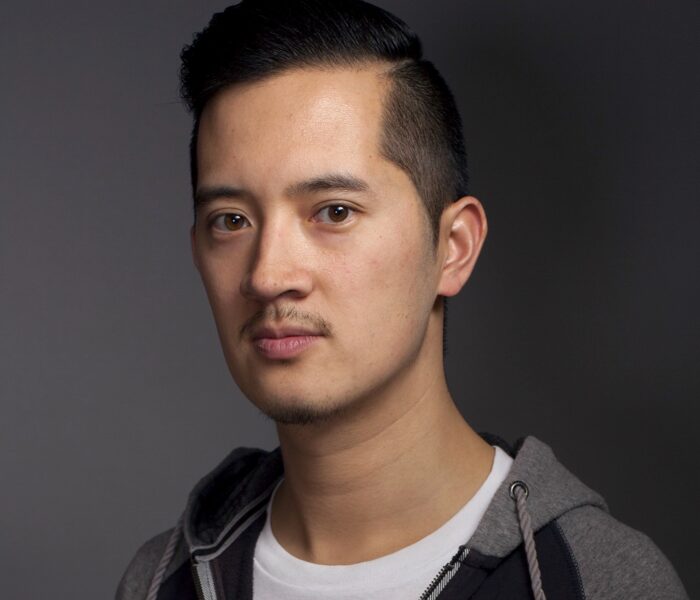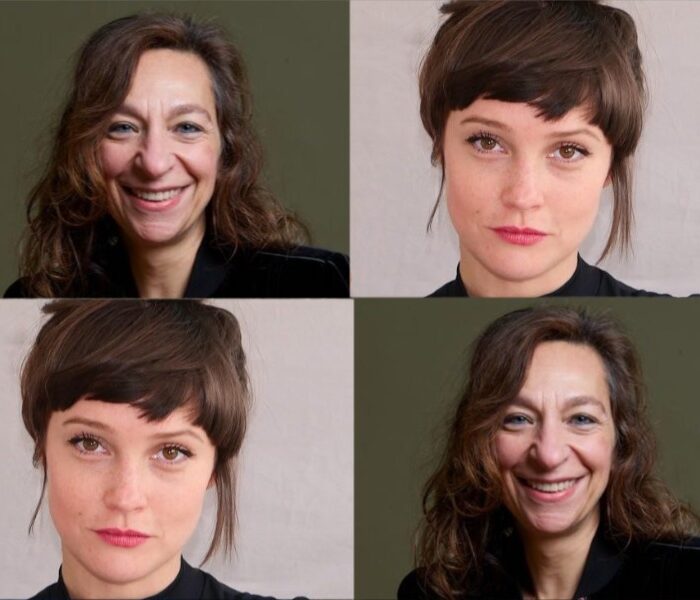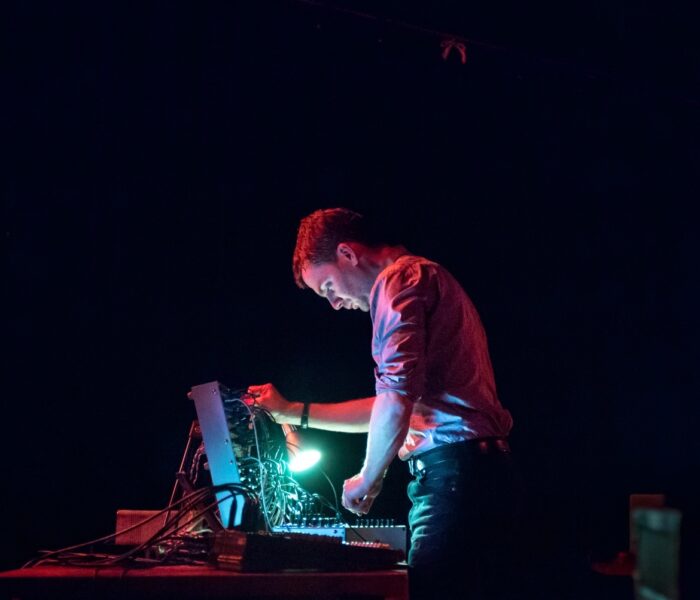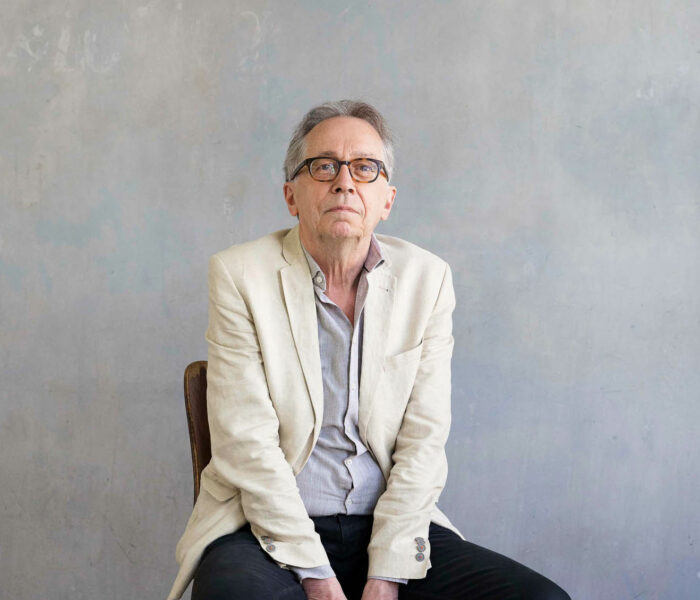In 1983, composer Louis Andriessen and composer and music critic Elmer Schönberger published the Dutch version of their groundbreaking book on Stravinsky: The Apollonian Clockwork . During the preparatory years, they became close friends, discussing many musical topics in detail. The text below capture one of these conversations, in fragments a three times larger interview that was originally published in Key Notes magazine in 1981*.
The latest composition by Louis AndriessenDe Tijd (Time), was premiered at the 1981 Holland Festival. De Tijd is set to a fragment of Saint Augustine's Confessions, and forms the third in a series of vocal-instrumental works. The first, De Staat (Republic, 1976), was dedicated to Plato; in the second, Mausoleum (1979), Andriessen drew on the Russian revolutionary anarchist, Mikhail Bakunin. The first measures of De Tijd were composed in March 1980. At the end of January 1981, when the conversations transcribed below took place, most of what had to be the final score of De Tijd still had to be written.
Elmer Schönberger: Do you compose regularly or by fits and starts?
Louis Andriessen: When working on a piece, as a rule, I compose every day, four or five hours on average. Always at the same time, too, between ten and three, say. I have come to see that if I work more invariably I lose those extra few hours somewhere along the line in the next few days.To keep going on a professional level I think one should maintain a day-by-day routine. Good physical condition is just as important, to my mind. Even drinking and smoking go according to a set plan when I am composing.
Do you begin writing straightaway when you begin at ten in the morning?
Before, I actually start composing I usually practice the piano for a while. Just scales, memorizing bits of Bach fugues. After that, I do little "sums" to make up chords, just like, when you start cooking, you put out the herbs you are going to use. To me it seems inconceivable to just start composing, hitting on some marvelous chords, and then deciding to do your sums.
You invariably compose on the piano. Does that mean that the piano is really doing the composing for you?
When one is younger there is always the danger that your hands are in charge, that you only think up chords which come easily to the fingers. I suppose that even now there are still some traces of that in my music. Many of the chords in De Tijd, though, are completely unplayable on the piano. Actually, Stravinsky’s music also has traces of the piano, much more so than Ravel’s. The ninth in the bass that Stravinsky is so fond of also is a pleasant stretch, although this is only of secondary interest. I was recently struck by something very strange about my music. In De Tijd, I was for the first time in years, using very high notes again. For ages I had only been working with the middle register. Lodewijk de Boer(1) suddenly realized why: because the top of my work table covered the upper part of the keys. I simply could not get at it.
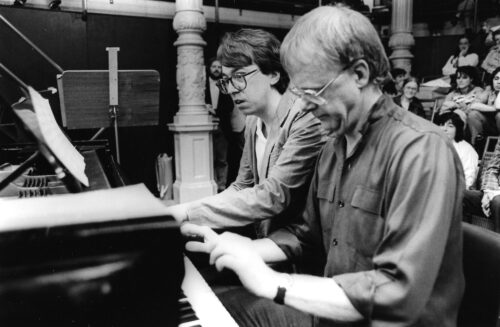
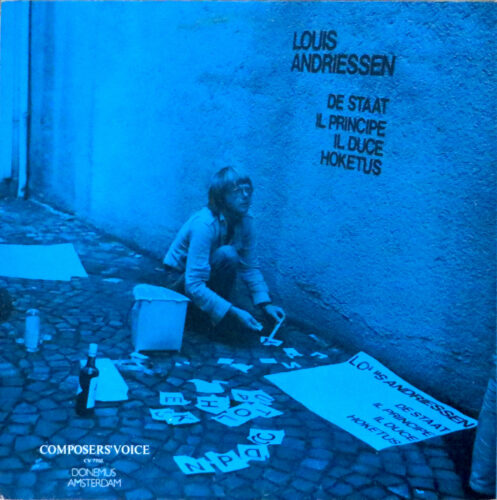
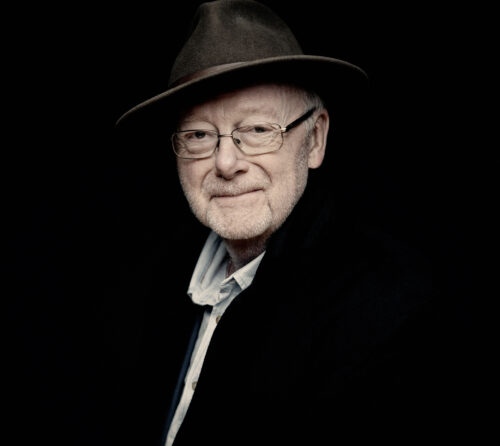
Composing for the same length of time every day doesn't mean composing the same amount every day, I suppose.
No, it doesn't. Days when you get through three pages are the exception. Sometimes you have to be satisfied with three or four measures. Or again, things might even be going too well. You have to remember the fact that composing, especially when it is going well, is an involving activity. Even Kees van Baaren(2), the most disciplined and coolest composer I have ever known, conceded this straightaway. Emotions can be a dangerous gauge. As soon as you get the feeling you are getting carried away you should stop and go off to do something else. Make coffee, do some skipping, or go shopping so that you can return to your desk cooled down and detached.
You told me once before about your latest composition, De Tijd,that non-musical factors play a greater part than musical thing in the creation of a work. Does that mean that the initial ideas are not musical ideas at all?
No, in the end that isn’t quite true. The original idea for De Tijd' was that of a musical situation; a situation of sustained, glorified musical motionlessness.
That sounds like the translation of a non-musical experience.
True. What stimulated my writing the piece was a unique experience that gave me the feeling time had ceased to exist; the sensation of an eternal moment. It was more than perfect inner peace. A euphoria that was so potent that I later decided to write a piece about it (3).
As a point of departure for a composition, that strikes me seems as being fairly abstract. Does it happen too, that large-scale "free" works - not operas, film music or other "functional" compositions - develop entirely from a purely musical idea, a flash?
I think you have to look at each case separately, although it is true that purely musical ideas, which give you the impetus to push on, do occur - especially in functional music. But the idea behind De Staat, for instance, wasn't all that abstract. De Staat was conceived a sort of multiplied De Volharding (Perseverance). What I couldn’t achieve with the De Volharding orchestra,due to technical limitations, I wanted to accomplish in another way. De Staatwas above all a musical vision. I myself saw it as a huge wall that very slowly collapses over you. Now that was a nonmusical description of a musical experience. I admit that with De Tijd, things did go quite differently. The musical idea into which I translated the experience I just described was far less concrete. But then, I was busy with it for almost two years before I put the first note on paper.
Busy in what way?
Reading a great many books, looking for texts. I was quite certain it ought to become a vocal work. That, after De Staat for Plato's texts and Mausoleum for Bakunin's, might sound a little like automatism but that does not alter the fact that finding the inspiration for the form, duration, motion and the like in a text is perfectly legitimate as far as I am concerned. You look out for a text which conveys what you want to say and at the same time is an aid for what you want to get across musically.
De Staat, Mausoleum and De Tijd are all big pieces for a large ensemble. Might not the use of text have something to do with a fear of big forms?
I don't think so. If you go off to Haarlem and take the car it doesn’t mean that you are afraid of walking. Anyway, using texts is an obvious device. The big musical forms, with the exception of Bruckner, perhaps, are always about more than just the music.
Have you written any pieces before that needed so much preparation as De Tijd did?
Never. With De Staat and Mausoleum, I did not begin writing notes from one day to the other either, but the preparatory work for those compositions was nothing in comparison with De Tijd. That had to do with the subject itself and the fact that never before I had so much difficulty in finding a musical solution for what was evidently not a solid enough musical experience in my head. I kept telling myself: "Now, just do nothing, but listen very hard, because you know perfectly well what you want to hear". Obviously,though, I didn’t. What I did during those two years can scarcely be reconstructed at this point. I started with Dijksterhuis's The Mechanization of the World Image and Dante's Divine Comedy, and ended with The Divine Comedy and Saint Augustine's Confessions(4). In-between lie stacks of books on seven centuries of ideas on time and a trip to Florence where, apart from peace and quiet, I was after a philosopher, a contemporary of Dante’s.
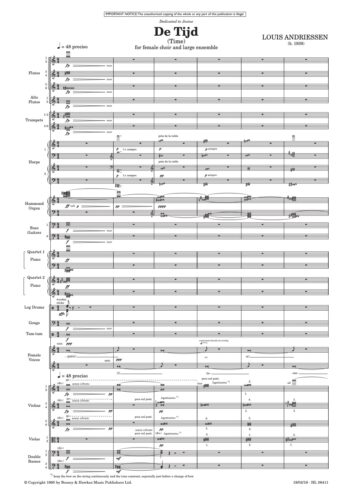
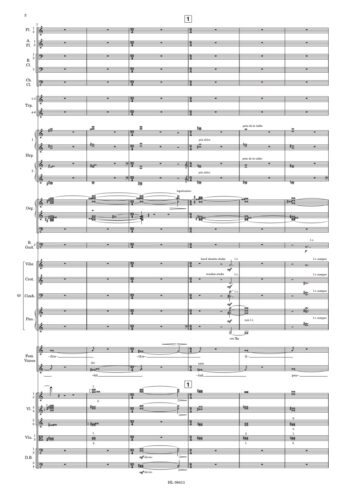
A composer of the post-Einsteinian era looking back to the late Middle Ages, in fact...
Not only that; I also threw myself in Readers' Digest-type books on relativityAlso books on clocks, books on calendar calculation, mathematics, histories of astrology. I even attempted to cope with Hans Reichenbach's Space and Time (5), but, lacking in scientific expertise, I found that I could not make heads or tails of it after about ten pages. Texts from, say, the period from Newton to Einstein when people knew what time was, were also out of question. I realized that I was after a philosophical unknown - which actually it is again since Einstein and Gauss - and that meant I had to go back further in history. Then, I got involved in the labyrinthine 14th century in which I found my way around with the greatest difficulty. Initially, I was looking for two sorts of texts: with a metaphysical slant and of a scientific kind, for instance texts which put my experience into words, and texts about the measurement of time. Dante - I thought at the time - was the poet; what I needed was his scientific counterpart. My intention was to combine those two types of texts. It could, for instance, have been through a simple closed form like the one represented in Figure 1 in which the uprights stand for short scientific statements on the 14th-century measurement of time and the base stands for a continuous poetic text in the form of a cantus firmus**.
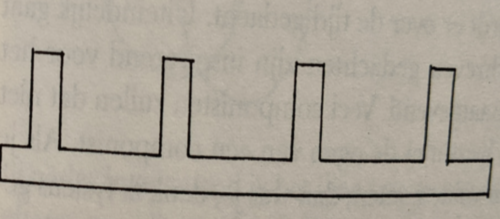
The oppositeness of those texts was the same as between the two books with which it all began Dijksterhuis(The Mechanization of the World Image) and Dante(The Divine Comedy). This was the biggest compositional problem of the piece, to which all other problems - harmony, instrumentation, texture - were subservient. Cutting through that knot was the hardest decision of all.
In the end, I opted for a closed form and just one sort of the text. But which sort, was the question. At first I though: "on 'no' account use metaphysical texts; no poetic descriptions of this emotional "void". No, the music itself should sound like that "void" and, in contrast, the text should deal with the measurement of time". When I got no further with that and, besides, got the feeling that I simply had to start writing otherwise I might carry on like that forever, I did a whole 180° turnabout. I concluded that the text should after all have to do with describing a point in eternity, metaphysics that is, and that the task of the music was to measure time.
Did you also have a musical criterion in the sense of a specific interval constellation, a rhythm, or a harmonic point of departure?
I had two altered dominant-seventh chords, at first even only one. It was a chord with a very long history, though. Years ago I once conceived the plan, should I ever again compose something for the symphony orchestra, of writing a piece built up of a single dominant-seventh chord, a piece which, from the compositional point of view, would have a great deal to say about that chord.
De Tijd is not tonal, yet you are talking of a tonal chord.
Formally speaking, I regard the search for solutions to the tonal/non-tonal controversy as the most important issue in contemporary music. The tradition of strict atonality or anti-tonality offers too little scope, as has by now become obvious, for the development of composition.
So the entire composition developed from this one chords?
Yes. Initially, the chord has the form of a dominant-seventh containing both a minor and major third and no fifth : Image 1
Only after a while I realized that for what I wanted to do with the piece, it would be better to take another form. A dominant-seventh chord, also without fifth but with the tonic added: Image 2
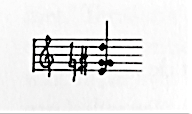
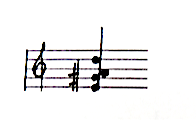
Playing this piece when I had got through about two thirds of the music I suddenly realized: if this turns out well I have accomplished something I wanted since 1972. It reminded me of an evening back then when visiting someone and being full of plans for big works - De Staat was still unwritten - I excitedly shouted: "I want to make a piece, all hair-raising blue pillars. Very long. Bangs. Silences." So, sitting at my piano many years later, I exclaimed in-between chords: "To do that you have to get past forty years." I think that only now I have been released from those blue pillars, though I am not quite sure about it yet. Maybe it has to be still heavier. Maybe it is all a still bigger vision.
With the collaboration of Mirjam Zegers*.
Louis Andriessen's works were presented by the Dutch ensemble Asko|Schönberg at the Musica festival on September 15 and 16.
With the support of Performing Arts Fund (NL)
Thanks to Monica Andriessen-Germino
* The full text is available in Louis Andriessen/Mirjam Zegers (ed.), The Art of Stealing Time (Todmorden, Arc Publications, 2002) and Maja Trochimczyk (ed.), The Music of Louis AndriessenRoutledge, New York/London, 2002
**Cantus firmus: in medieval and Renaissance music, the cantus firmus (fixed song, around which everything is ordered) is a pre-existing melody (usually religious, but also secular) serving as the basis for polyphony.
(1) Lodewijk de Boer (1906-2004), a Dutch “musician, playwright and theater director” [composer’s note]. He performed Frans Brüggen’s early music ensemble. During the 1970s-1980s, they directed several theatrical productions for Toneelgroep Baal, including Mattheus Passie (1976), Orpheus (1977), George Sand (1980) and Doctor Nero (1984).
(2) Kees van Baaren was Andriessen's composition teacher at the Royal Conservatory in The Hague.
(3) As he added later, during a lecture in Kazimierz Dolny, for the Summer Courses for Young Composers organized by the Polish Section of the ISCM in September 1985: "It was was an experience that we all have probably experienced or will experience once or twice in a lifetime. It is an experience of an awareness of the stopping of time, a feeling of complete tranquility. Obviously, it has to do with love. When I experienced this feeling it was so strong that I decided to compose a piece of music about it". (Excerpt from Louis Andriessen, Lecture 2: De Tijd (Time), in: Maja Trochimczyk (ed.), The Music of Louis Andriessen, Routledge, New York/London, 2002, p.137).
(4) E.J. Dijksterhuis (Eduard Jan; 1892-1965), was a historian of science. The Mechanization of the World Picture, trans. C. Dijkshoorn (Oxford: Oxford University Press, 1961, 1964, 1969).
(5) Hans Reichenbach (1891-1953), The Philosophy of Space & Time, trans. Maria Reichenbach and John Freund (New York: Dover Publications, 1957).
Photo © Francesca Patella
Photo © Marco Borggreve
Photo © Floris Guntenaar
Photos partition © Copyright 1994 by Boosey & Hawkes Music Publishers Ltd.



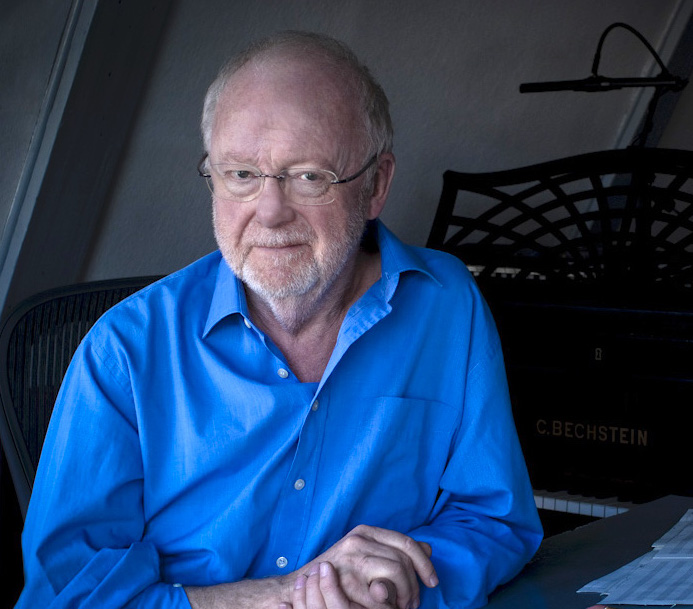)
